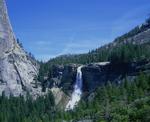National Park Service Begins Process to Revise Backcountry Management Plan for Grand Canyon National Park
Date: April 27, 2011
Contact: Maureen Oltrogge, 928-638-7779
Contact: Rachel Bennett, 928-638-7326
Grand Canyon, Ariz. – Grand Canyon National Park's Acting Superintendent, Jane Lyder, announced today that a Notice of Intent (NOI) to prepare an Environmental Impact Statement (EIS) and revised Backcountry Management Plan has been published in the Federal Register. This announcement begins the NEPA (National Environmental Policy Act) process of identifying, analyzing and disclosing the potential impacts of actions that could be taken to manage Grand Canyon's extensive backcountry resources.
The park's existing Backcountry Management Plan (BMP) was completed in 1988 and needs to be updated in order to comply with current National Park Service (NPS) laws and policies and the park's 1995 General Management Plan. Development of a revised plan provides an opportunity to look at alternative management strategies for protecting park resources and values while providing for a variety of visitor experiences within the backcountry. The EIS will describe the relationship of the BMP to other plans and NEPA documents, such as the Colorado River Management Plan, Mule Operations and Stock Use Plan, Fire Management Plan, and the Draft EIS for Special Flight Rules.
One of the first steps in the development of an EIS is public scoping. Scoping is an opportunity for the public to provide early ideas about a plan and the alternatives that should be considered, thus defining the "scope" of the plan. The NPS is currently in the scoping phase of the EIS for Grand Canyon's BMP.
To begin the NEPA process, the NPS will look at a very fundamental question: What should Grand Canyon National Park's backcountry and wilderness be like in the future? In defining the scope of this plan, park planners want to capture a sense of what people consider to be an ideal backcountry experience and what they would like Grand Canyon's backcountry and wilderness resources to look like 20 years from now.
Grand Canyon's "backcountry" consists of the primitive, undeveloped portions of the park (which include proposed wilderness, non-wilderness and the Colorado River corridor.) There are over 1.1 million acres of proposed wilderness in Grand Canyon National Park, comprising approximately 94 percent of the park's total area. For the purposes of this planning effort, "backcountry" will also include the cross-canyon corridor and Tuweep. The 2006 Colorado River Management Plan provides direction for river use, and will not be considered in this planning effort.
Among the important issues that will be examined in the EIS are visitor access and use of the park's backcountry, administrative use and park infrastructure, scientific research activities, commercial services, access through tribal lands, management of natural and cultural resources, and protection of wilderness character. Once completed, the revised BMP will guide management decisions regarding the park's backcountry and wilderness resources into the future.
"We genuinely want and need the public's input on the park's Backcountry Management Plan," said Jane Lyder, Grand Canyon National Park's Acting Superintendent. "Public participation is an integral part of the planning process and thoughtful comments are critical to achieving the best plan possible."
To facilitate public participation, three open house-style public scoping meetings will be held in May and June in Grand Canyon Village on the South Rim of Grand Canyon National Park; Kanab, Utah; and Flagstaff, Arizona. Specific dates, times and locations will be announced in the local media and on the internet at http://parkplanning.nps.gov/grca. These meetings will provide the public with information on this planning process as well as opportunities to engage with park staff, ask questions, and submit comments and suggestions.
Scoping comments will be accepted for 60 days, through June 27, 2011. Written comments may be submitted via the internet at http://parkplanning.nps.gov/grca (the preferred method); by mail to Superintendent Grand Canyon National Park, Attn: Backcountry Management Plan, P.O. Box 129, Grand Canyon, Arizona 86023; by hand-delivery to Park Headquarters, 1 Village Loop, Grand Canyon, Arizona or at one of the open house meetings.
The input of Traditionally Associated Tribes will also be sought through government to government consultation.
The NPS will analyze, consider and incorporate the ideas and suggestions received during the scoping process into a range of draft alternatives to be analyzed in the Draft EIS. It is anticipated that a Draft EIS will be available for review and comment in 2012.
To learn more about Grand Canyon National Park's backcountry management planning effort, please contact Rachel Bennett, Environmental Protection Specialist, at 928-638-7326 or visit us on the web at http://parkplanning.nps.gov/grca.
National Park Service Begins Process to Revise Backcountry Management Plan for Grand Canyon National Park
All posts are those of the individual authors and the owner
of this site does not endorse them. Content should be considered opinion
and not fact until verified independently.
Sorry, only registered users may post in this forum.


